高速公路雷达探测资料分析
探地雷达在公路工程检测中的应用分析
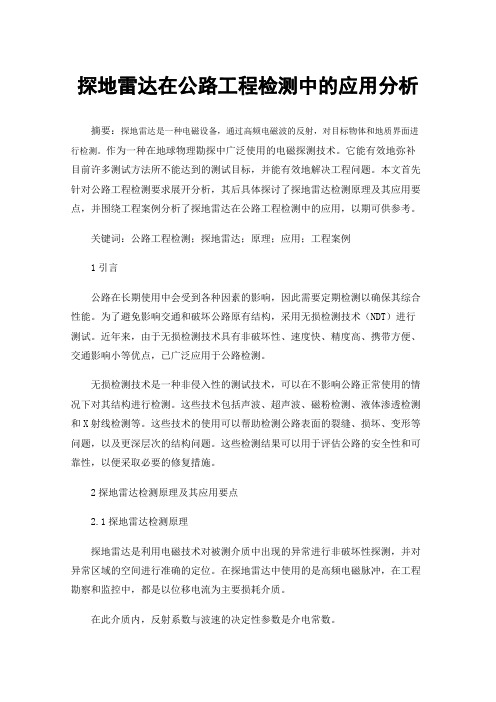
探地雷达在公路工程检测中的应用分析摘要:探地雷达是一种电磁设备,通过高频电磁波的反射,对目标物体和地质界面进行检测。
作为一种在地球物理勘探中广泛使用的电磁探测技术。
它能有效地弥补目前许多测试方法所不能达到的测试目标,并能有效地解决工程问题。
本文首先针对公路工程检测要求展开分析,其后具体探讨了探地雷达检测原理及其应用要点,并围绕工程案例分析了探地雷达在公路工程检测中的应用,以期可供参考。
关键词:公路工程检测;探地雷达;原理;应用;工程案例1引言公路在长期使用中会受到各种因素的影响,因此需要定期检测以确保其综合性能。
为了避免影响交通和破坏公路原有结构,采用无损检测技术(NDT)进行测试。
近年来,由于无损检测技术具有非破坏性、速度快、精度高、携带方便、交通影响小等优点,已广泛应用于公路检测。
无损检测技术是一种非侵入性的测试技术,可以在不影响公路正常使用的情况下对其结构进行检测。
这些技术包括声波、超声波、磁粉检测、液体渗透检测和X射线检测等。
这些技术的使用可以帮助检测公路表面的裂缝、损坏、变形等问题,以及更深层次的结构问题。
这些检测结果可以用于评估公路的安全性和可靠性,以便采取必要的修复措施。
2探地雷达检测原理及其应用要点2.1探地雷达检测原理探地雷达是利用电磁技术对被测介质中出现的异常进行非破坏性探测,并对异常区域的空间进行准确的定位。
在探地雷达中使用的是高频电磁脉冲,在工程勘察和监控中,都是以位移电流为主要损耗介质。
在此介质内,反射系数与波速的决定性参数是介电常数。
式(1)和式(2)中:ε为相对介电常数;r为反射系数;c为光速;v为速度;1为上介质;2为下介质。
空气、水相对介电常数分别是1、81。
在实际探测过程中,介质波速v、天线距x以及信号返回时间t已经确定,如此,研究对象的界面表征距离通常能表示成:鉴于此,能明确异常电性界面距离,之后还能借助波形异常区间的形态规格,分析研究对象的具体尺度。
2.2探地雷达数据处理针对雷达波的特征,对雷达资料进行了处理,并对其进行了以下步骤:①偏移处理。
高速公路雷达测速仪原理高中物理
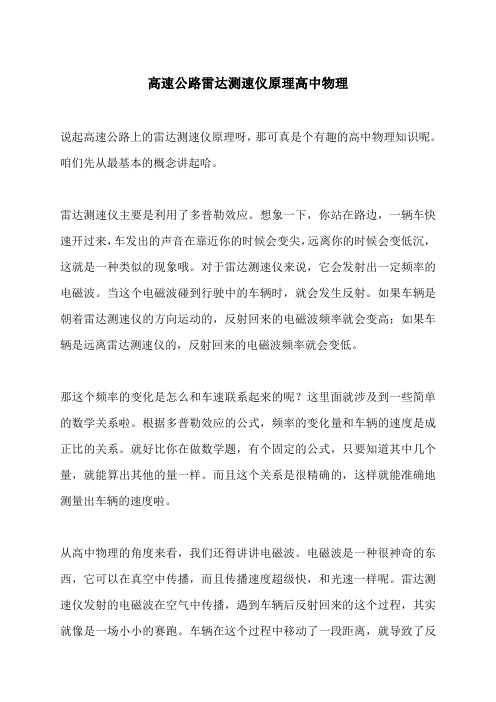
高速公路雷达测速仪原理高中物理说起高速公路上的雷达测速仪原理呀,那可真是个有趣的高中物理知识呢。
咱们先从最基本的概念讲起哈。
雷达测速仪主要是利用了多普勒效应。
想象一下,你站在路边,一辆车快速开过来,车发出的声音在靠近你的时候会变尖,远离你的时候会变低沉,这就是一种类似的现象哦。
对于雷达测速仪来说,它会发射出一定频率的电磁波。
当这个电磁波碰到行驶中的车辆时,就会发生反射。
如果车辆是朝着雷达测速仪的方向运动的,反射回来的电磁波频率就会变高;如果车辆是远离雷达测速仪的,反射回来的电磁波频率就会变低。
那这个频率的变化是怎么和车速联系起来的呢?这里面就涉及到一些简单的数学关系啦。
根据多普勒效应的公式,频率的变化量和车辆的速度是成正比的关系。
就好比你在做数学题,有个固定的公式,只要知道其中几个量,就能算出其他的量一样。
而且这个关系是很精确的,这样就能准确地测量出车辆的速度啦。
从高中物理的角度来看,我们还得讲讲电磁波。
电磁波是一种很神奇的东西,它可以在真空中传播,而且传播速度超级快,和光速一样呢。
雷达测速仪发射的电磁波在空气中传播,遇到车辆后反射回来的这个过程,其实就像是一场小小的赛跑。
车辆在这个过程中移动了一段距离,就导致了反射波频率的变化。
另外呀,雷达测速仪的工作还需要一些设备来接收和处理反射回来的电磁波。
这个设备要能够很灵敏地捕捉到频率的变化,然后通过内部的电路进行计算,最后得出车辆的速度。
这就好比人的大脑接收信息然后进行处理一样,这些设备就是雷达测速仪的“大脑”呢。
在高速公路上,雷达测速仪可是发挥着很大的作用哦。
它可以确保车辆按照规定的速度行驶,保障交通安全。
要是没有它,有些司机可能就会开得太快啦,那可就危险咯。
概括性来讲呢,高速公路雷达测速仪原理虽然听起来有点复杂,但只要从高中物理的基础概念去理解,就会发现它其实很有趣的啦。
探地雷达技术在高速公路检测方面的应用研究
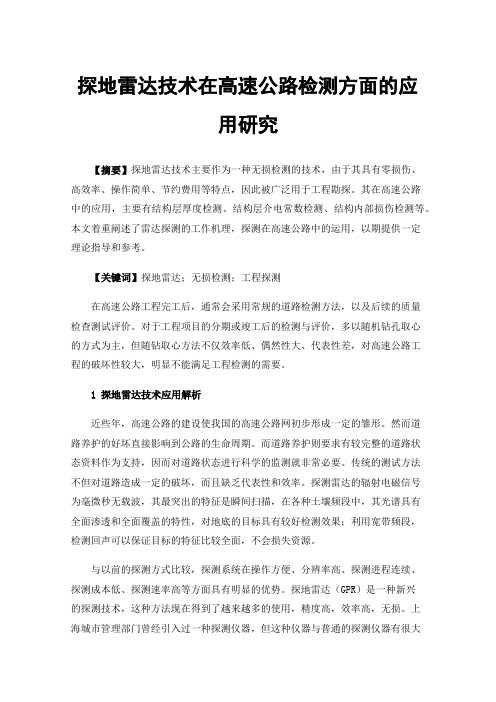
探地雷达技术在高速公路检测方面的应用研究【摘要】探地雷达技术主要作为一种无损检测的技术,由于其具有零损伤、高效率、操作简单、节约费用等特点,因此被广泛用于工程勘探。
其在高速公路中的应用,主要有结构层厚度检测、结构层介电常数检测、结构内部损伤检测等。
本文着重阐述了雷达探测的工作机理,探测在高速公路中的运用,以期提供一定理论指导和参考。
【关键词】探地雷达;无损检测;工程探测在高速公路工程完工后,通常会采用常规的道路检测方法,以及后续的质量检查测试评价。
对于工程项目的分期或竣工后的检测与评价,多以随机钻孔取心的方式为主,但随钻取心方法不仅效率低、偶然性大、代表性差,对高速公路工程的破坏性较大,明显不能满足工程检测的需要。
1探地雷达技术应用解析近些年,高速公路的建设使我国的高速公路网初步形成一定的雏形。
然而道路养护的好坏直接影响到公路的生命周期。
而道路养护则要求有较完整的道路状态资料作为支持,因而对道路状态进行科学的监测就非常必要。
传统的测试方法不但对道路造成一定的破坏,而且缺乏代表性和效率。
探测雷达的辐射电磁信号为毫微秒无载波,其最突出的特征是瞬间扫描,在各种土壤频段中,其光谱具有全面渗透和全面覆盖的特性,对地底的目标具有较好检测效果;利用宽带频段,检测回声可以保证目标的特征比较全面,不会损失资源。
与以前的探测方式比较,探测系统在操作方便、分辨率高、探测进程连续、探测成本低、探测速率高等方面具有明显的优势。
探地雷达(GPR)是一种新兴的探测技术,这种方法现在得到了越来越多的使用,精度高,效率高,无损。
上海城市管理部门曾经引入过一种探测仪器,但这种仪器与普通的探测仪器有很大的不同,区别在于高技术水平。
所以,目前在地质勘探方面的研究还比较局限,没有充分利用这种仪器的经验,而工程师们还没有能很好理解和处理这些资料。
若能在公路上广泛应用,则可迅速完成下列工作:旧路的改建与评定、设计资料的勘察与收集、施工质量控制、探测病害隐患、研究检测设备应用技术、监察与仲裁工程质量的事故成因、对路面的材料和结构进行深入研究等。
刍议雷达法在公路检测中的应用
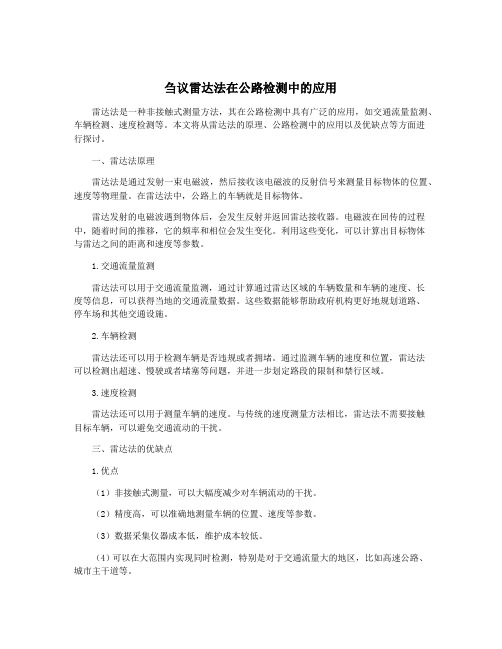
刍议雷达法在公路检测中的应用雷达法是一种非接触式测量方法,其在公路检测中具有广泛的应用,如交通流量监测、车辆检测、速度检测等。
本文将从雷达法的原理、公路检测中的应用以及优缺点等方面进行探讨。
一、雷达法原理雷达法是通过发射一束电磁波,然后接收该电磁波的反射信号来测量目标物体的位置、速度等物理量。
在雷达法中,公路上的车辆就是目标物体。
雷达发射的电磁波遇到物体后,会发生反射并返回雷达接收器。
电磁波在回传的过程中,随着时间的推移,它的频率和相位会发生变化。
利用这些变化,可以计算出目标物体与雷达之间的距离和速度等参数。
1.交通流量监测雷达法可以用于交通流量监测,通过计算通过雷达区域的车辆数量和车辆的速度、长度等信息,可以获得当地的交通流量数据。
这些数据能够帮助政府机构更好地规划道路、停车场和其他交通设施。
2.车辆检测雷达法还可以用于检测车辆是否违规或者拥堵。
通过监测车辆的速度和位置,雷达法可以检测出超速、慢驶或者堵塞等问题,并进一步划定路段的限制和禁行区域。
3.速度检测雷达法还可以用于测量车辆的速度。
与传统的速度测量方法相比,雷达法不需要接触目标车辆,可以避免交通流动的干扰。
三、雷达法的优缺点1.优点(1)非接触式测量,可以大幅度减少对车辆流动的干扰。
(2)精度高,可以准确地测量车辆的位置、速度等参数。
(3)数据采集仪器成本低,维护成本较低。
(4)可以在大范围内实现同时检测,特别是对于交通流量大的地区,比如高速公路、城市主干道等。
(5)不受天气等环境干扰。
2.缺点(1)电磁波在传输过程中易受到障碍物的影响,容易产生误判。
(2)需要投入较高的研发费用,以确保系统的可靠性和准确性。
对于一些小城市和乡村地区,设备的投入成本可能就会较高。
(3)对于远距离、高速行驶的车辆而言,雷达法的检测难度较大。
综上所述,雷达法在公路检测中具有广泛的应用前景,特别是对于交通流量监测、车辆检测、速度检测等,都能够发挥很好的作用。
与此同时,也需要不断提高设备的技术水平,以更好地服务于公路监测工作的需求。
雷达测速原理
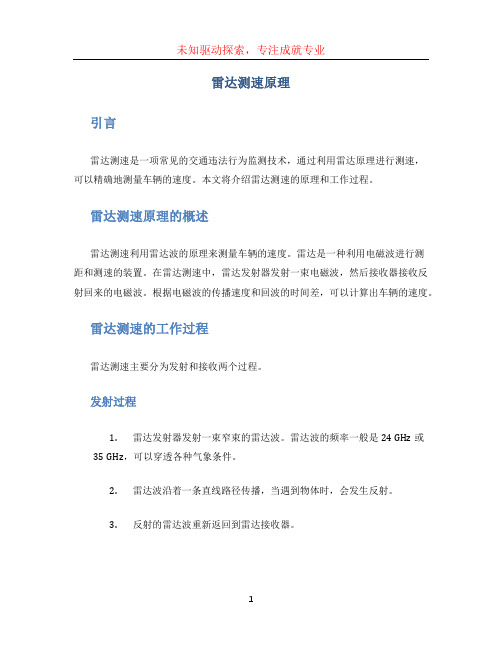
雷达测速原理引言雷达测速是一项常见的交通违法行为监测技术,通过利用雷达原理进行测速,可以精确地测量车辆的速度。
本文将介绍雷达测速的原理和工作过程。
雷达测速原理的概述雷达测速利用雷达波的原理来测量车辆的速度。
雷达是一种利用电磁波进行测距和测速的装置。
在雷达测速中,雷达发射器发射一束电磁波,然后接收器接收反射回来的电磁波。
根据电磁波的传播速度和回波的时间差,可以计算出车辆的速度。
雷达测速的工作过程雷达测速主要分为发射和接收两个过程。
发射过程1.雷达发射器发射一束窄束的雷达波。
雷达波的频率一般是24 GHz或35 GHz,可以穿透各种气象条件。
2.雷达波沿着一条直线路径传播,当遇到物体时,会发生反射。
3.反射的雷达波重新返回到雷达接收器。
接收过程1.雷达接收器接收反射回来的雷达波。
2.接收到的雷达波通过信号处理进行滤波和放大。
3.通过计算接收到的雷达波的时间差,可以得到距离。
4.通过计算距离的变化速度,可以得到车辆的速度。
雷达测速原理的特点雷达测速具有以下特点:1.非接触式:雷达测速不需要与车辆直接接触,可以在一定范围内进行测速。
2.高精度:雷达测速可以提供高精度的测速结果,通常误差在1%以内。
3.多目标测速:雷达测速可以同时测量多个目标的速度,适用于密集车流的场景。
4.不受环境条件限制:雷达波在传播过程中对气象条件不敏感,不受雨、雪等恶劣天气的影响。
雷达测速原理的应用雷达测速广泛应用于交通管理和违法行为监测领域。
通过对道路上行驶车辆的测速,可以及时发现超速行驶、违规变道等交通违法行为,并采取相应的处罚措施。
结论雷达测速利用雷达波的原理来测量车辆的速度,具有非接触式、高精度和多目标测速等特点。
它已成为交通管理和违法行为监测的重要工具。
随着技术的不断进步,雷达测速技术将不断发展,并在交通安全领域发挥更大的作用。
以上就是雷达测速原理的介绍,希望对您有所帮助!。
LTD探地雷达在高速公路建设中的应用分析

LTD探地雷达在高等级公路建设中的应用分析于景兰中国电波传播研究所·青岛·266107摘要随国内经济的飞速发展,国家基础建设投资规模不断增大,公路工程质量控制得到空前重视。
基于探地雷达高精度、连续的无损检测方式,其在公路面基层厚度和路面下存在缺陷检测中的应用日益得到重视。
本文首先对国产LTD探地雷达的基本原理给予简单介绍,接着重点对其在公路建设前期的地质勘察、施工质量检测和后期维护中的应用实例加以分析,最后就探地雷达技术在公路建设中的应用前景作一展望。
关键词探地雷达无损检测地质勘察面基层厚度计算缺陷探测前景展望0 引言随着经济的飞速发展,各项基础设施建设也呈现出良好的发展势头。
交通作为国民经济的命脉,其发展状况直接影响国民经济发展的速度,在整个交通运输体系中,公路又是基础中的基础。
近几年来,国家每年投资成百上千亿资金来修建公路,全国的高速公路迅猛发展,形势十分喜人。
但同时也产生了一些新的问题,如现有落后的公路检测手段和高速发展的公路建设之间的矛盾,怎样保证又快又好地检测施工质量,如何提高公路养护管理的水平等,都是一些亟待解决和探讨的问题。
1 常规检测和维护方法的局限性我们知道,在公路施工中,为确保工程质量,从夯实地基、碾压每层路基,到灌注水泥砼层路面或沥青路面,每道工序都需要严格检测。
传统的方法是根据规程随机选点,钻孔取样、进行室内分析处理,从中获取厚度、深度、压实度和强度等工程参数。
然而,这种常规方法存在一定的局限性:首先被测点是随机选择的,因而检测结果往往缺乏代表性。
同时,由于检测点的密度稀,有些局部压实度达不到标准、厚度偏小、水泥混凝土或沥青内部存在的缺陷等不良区段极易漏检,给后续工程工作留下隐患。
另外,在道路投入使用后的日常维护管理中,通常对路表面出现的破损、凹陷、裂缝、平整等问题可以及时发现,但对道路内部存在的隐性灾害,如路面下的空洞、积水、脱空、基础疏松等却无有效的检测手段,难以做到防患于未然,随着冬冰夏融,热胀冷缩以及日积月累的冲压,往往容易导致重大交通事故的发生,使人民生命财产造成巨大的损失。
在公路工程检测中探地雷达的应用分析

在公路工程检测中探地雷达的应用分析摘要:现阶段,社会经济迅猛发展,公路行业也在同步发展,在整个业界中,公路质检占据了重要的地位。
对于探地雷达而言,其属于一种无损检测技术,可以对公路工程质量进行全面的探测,还可以实现经营管理状况的高效探测。
基于此,本篇文章主要对在公路工程检测中探地雷达的应用进行深入分析和探讨。
关键词:公路工程检测;探地雷达;应用分析前言:现如今,最为先进的一种无损探测工具,就是探地雷达,不论是在公路领域之中,还是在隧道领域之中,均得到了广泛推广和应用,对比原本的钻孔取芯和室内试验手段,将探地雷达这一技术应用进来,不但具备无损的特点,还具备迅速的优势,可以对路基故障范围进行精准的确定,对病害成因及类型进行全面的探究和判断,尤其是对于地质条件的性能探测,具备的优势是其他技术所无法比拟的。
1.探地雷达系统构成对于探地雷达系统而言,其不但包含了配电电源和仪器主机,还将发射器和接收器同步包含了进来,此外,还有信号处置和结果呈现以及收发天线等部分。
1.1.发射器从本质上来讲,发射器主要就是以线路为依据,达到能量存储的目的,而且可以实现短期内的释放,使一种相对较强的脉冲和单周期雷达信号得以形成,通过分离器之后,进一步传导到天线之中,通过天线的利用,使该电磁波被进一步传入到路面系统之中。
1.1.接收器对于探地雷达的接收器而言,其最为关键的内容,就是高速取样线路,主要作用,就是对反射信号进行实时的获取,同时,还可以对此种信号进行实时的扩大,然后传导高信号到信号处理器之中,对实际获取的信号,进行高效全面的处理。
1.1.天线对于天线而言,其可以对电磁波信号发射和接收反射信号进行同步完成,公路的探地雷达系统实际对应的天线种类,主要有两种,首先第一种,就是地表耦合型天线;第二种,就是空气耦合型天线。
1.1.分离机射频在发射的过程中,在发射器和天线之间,可以将分离机应用进来,达到联结的目的,并且在处理完成短时发射之后,分离机可以对发射器和天线之间的链接进行断开,再一次对接收机和天线进行联结。
路桥检测中雷达检测技术的应用分析
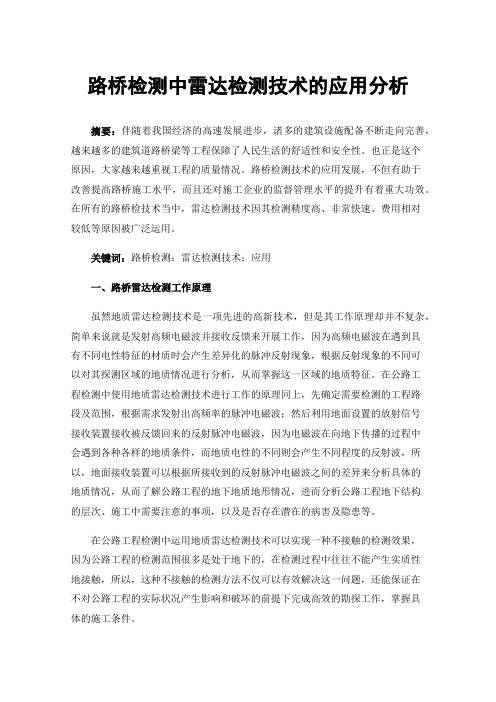
路桥检测中雷达检测技术的应用分析摘要:伴随着我国经济的高速发展进步,诸多的建筑设施配备不断走向完善,越来越多的建筑道路桥梁等工程保障了人民生活的舒适性和安全性。
也正是这个原因,大家越来越重视工程的质量情况。
路桥检测技术的应用发展,不但有助于改善提高路桥施工水平,而且还对施工企业的监督管理水平的提升有着重大功效。
在所有的路桥检技术当中,雷达检测技术因其检测精度高、非常快速、费用相对较低等原因被广泛运用。
关键词:路桥检测;雷达检测技术;应用一、路桥雷达检测工作原理虽然地质雷达检测技术是一项先进的高新技术,但是其工作原理却并不复杂,简单来说就是发射高频电磁波并接收反馈来开展工作,因为高频电磁波在遇到具有不同电性特征的材质时会产生差异化的脉冲反射现象,根据反射现象的不同可以对其探测区域的地质情况进行分析,从而掌握这一区域的地质特征。
在公路工程检测中使用地质雷达检测技术进行工作的原理同上,先确定需要检测的工程路段及范围,根据需求发射出高频率的脉冲电磁波;然后利用地面设置的放射信号接收装置接收被反馈回来的反射脉冲电磁波,因为电磁波在向地下传播的过程中会遇到各种各样的地质条件,而地质电性的不同则会产生不同程度的反射波,所以,地面接收装置可以根据所接收到的反射脉冲电磁波之间的差异来分析具体的地质情况,从而了解公路工程的地下地质地形情况,进而分析公路工程地下结构的层次、施工中需要注意的事项,以及是否存在潜在的病害及隐患等。
在公路工程检测中运用地质雷达检测技术可以实现一种不接触的检测效果,因为公路工程的检测范围很多是处于地下的,在检测过程中往往不能产生实质性地接触,所以,这种不接触的检测方法不仅可以有效解决这一问题,还能保证在不对公路工程的实际状况产生影响和破坏的前提下完成高效的勘探工作,掌握具体的施工条件。
二、雷达检测技术在路桥检测中的具体应用雷达检测技术是一种方便、高效、准确、无损的检测手段,在应用过程中可以根据检测需求进行灵活的安排与调整,可以深入了解与分析勘测路段的结构,及时发现质量问题,因此在路桥施工过程中的应用十分广泛。
刍议雷达法在公路检测中的应用

刍议雷达法在公路检测中的应用【摘要】雷达技术在公路检测中的应用已经成为公路管理领域的重要工具。
利用雷达技术可以实时监测车辆速度、密度和流量等信息,为交通管理提供更精准的数据支持。
雷达法在车辆监测中具有快速、准确的优势,可以帮助监测超速行为、拥堵情况和违规行为,提高交通管理效率。
雷达技术也在预防交通事故和提高道路安全方面发挥着重要作用,可及时发现潜在的危险行为并加强监控。
未来,随着技术的不断进步和应用范围的扩大,雷达技术在公路检测领域的发展前景广阔,将为公路安全领域带来更多的创新和进步。
雷达技术在公路检测中的应用不仅提高了交通管理的效率和准确性,同时也为公路安全领域的发展带来新的希望。
【关键词】雷达法、公路检测、车辆监测、交通管理、事故预防、道路维护、未来发展、公路安全、前景、雷达技术、重要性、价值、总结。
1. 引言1.1 背景介绍从古至今,道路交通一直是人类社会发展的重要组成部分。
随着汽车数量的增加和道路网络的扩展,如何保障公路交通的安全性和顺畅性成为了亟待解决的问题。
传统的公路检测方式往往需要人力和时间成本较高,而且存在一定的局限性。
如何利用先进的技术手段实现公路检测的高效化和智能化成为了当前研究的热点之一。
结合雷达技术与公路检测的需求,将雷达技术应用于公路检测领域具有重要意义和广阔前景。
通过本文对雷达法在公路检测中的应用进行探讨和分析,可以更好地认识雷达技术在公路交通领域的作用,为其进一步发展和应用提供参考和借鉴。
1.2 雷达技术概述雷达技术是一种通过发射和接收无线电波来探测目标的技术。
雷达系统通常由发射机、天线、接收机和信号处理器组成。
发射机会发射一束无线电波,当这些波与目标碰撞时,会被目标反射回来并被接收机接收。
通过分析接收到的信号,雷达系统可以确定目标的位置、速度和其他重要信息。
雷达技术在公路检测中的应用是通过在公路上安装雷达设备来监测车辆的行驶情况。
这些雷达设备可以实时监测车辆的速度、车距、车道偏离等信息,帮助交通管理部门及时发现并处理交通违规行为。
探地雷达在高速公路病害检测中的应用

探地雷达在高速公路病害检测中的应用摘要:高速公路运营养护过程中经常出现道路基层开裂、空洞等病害,在众多病害中,基层等深层结构病害是最难发现和判别的,通常此类病害在后期都以路面反射裂缝的形式表现出来,由于较难界定病害成因,实际养护维修中按面层病害进行铣刨加罩处治,难达到理想的维修效果,不但耗费人力、物力和财力,还频繁增加封道次数,给道路运营通畅和养护人员安全带来负面影响。
由此可见,若能事先探测面层下部结构状况,提前预警和诊断病害类型,并在养护作业中采取针对性维修措施将事半功倍。
鉴于此,本文主要分析探讨了探地雷达在高速公路病害检测中的应用情况,以供参阅。
关键词:探地雷达;高速公路;病害检测;应用引言随着高速公路营运年限的增加,交通量大、严重超载等情况的存在和雨水的侵蚀作用,部分高速公路出现一系列的公路病害。
若不及时进行治理,路面在交通荷载的作用下,使用性能将会迅速下降。
这不仅大大降低了高速公路的安全、快速、舒适行车的使用功能,还增加了公路养护成本。
所以分析高速公路路基、路面暴露出的典型病害,包括桥头跳车、桥头搭板脱空、涵管顶及两侧脱空、路面裂缝、网裂、路基脱空、车辙、水损坏、桥面破损等一系列病害是很有必要的。
这些高速公路病害的初期具有隐蔽性,而常规的钻孔取芯试验、探坑挖验、路表断面测量等检测方法,具有对路面的破坏性、检测深度有限、采样点有限、检测结果随机性大、代表性差、效率低等缺点,为此急需发展一种快速、有效、简便的高速公路病害检测技术。
探地雷达(Ground Penetrating Radar,GPR) 是利用高频宽带电磁波来探测地下结构和目标体的一种重要浅部地球物理检测方法 E,它具有效率高、分辨率高、无损性、抗干扰能力强、结果直观等特点,非常适用于高速公路的快速无损检。
探地雷达测试原理探地雷达法是一种通过发射和接收高频率、短脉冲电磁波(一般10MHz~2500MHz),并根据接收到的电磁波的振幅、波形和频率等特征来分析和推断地下介质结构、地层岩性特征的浅层地球物理探测技术,具有高采样率、无损连续检测等优点,探测精度和分辨能力达到厘米级。
公路工程试验检测中探地雷达的应用分析
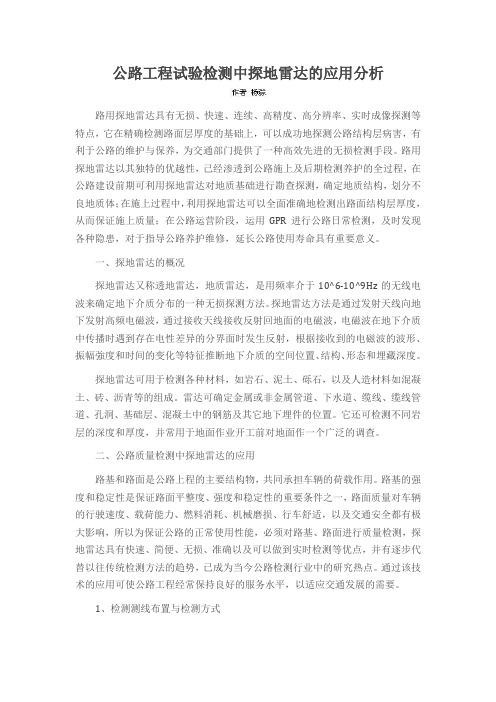
公路工程试验检测中探地雷达的应用分析路用探地雷达具有无损、快速、连续、高精度、高分辨率、实时成像探测等特点,它在精确检测路面层厚度的基础上,可以成功地探测公路结构层病害,有利于公路的维护与保养,为交通部门提供了一种高效先进的无损检测手段。
路用探地雷达以其独特的优越性,己经渗透到公路施上及后期检测养护的全过程,在公路建设前期可利用探地雷达对地质基础进行勘查探测,确定地质结构,划分不良地质体;在施上过程中,利用探地雷达可以全面准确地检测出路面结构层厚度,从而保证施上质量;在公路运营阶段,运用GPR进行公路日常检测,及时发现各种隐患,对于指导公路养护维修,延长公路使用寿命具有重要意义。
一、探地雷达的概况探地雷达又称透地雷达,地质雷达,是用频率介于10^6-10^9Hz的无线电波来确定地下介质分布的一种无损探测方法。
探地雷达方法是通过发射天线向地下发射高频电磁波,通过接收天线接收反射回地面的电磁波,电磁波在地下介质中传播时遇到存在电性差异的分界面时发生反射,根据接收到的电磁波的波形、振幅強度和时间的变化等特征推断地下介质的空间位置、结构、形态和埋藏深度。
探地雷达可用于检测各种材料,如岩石、泥土、砾石,以及人造材料如混凝土、砖、沥青等的组成。
雷达可确定金属或非金属管道、下水道、缆线、缆线管道、孔洞、基础层、混凝土中的钢筋及其它地下埋件的位置。
它还可检测不同岩层的深度和厚度,并常用于地面作业开工前对地面作一个广泛的调查。
二、公路质量检测中探地雷达的应用路基和路面是公路上程的主要结构物,共同承担车辆的荷载作用。
路基的强度和稳定性是保证路面平整度、强度和稳定性的重要条件之一,路面质量对车辆的行驶速度、载荷能力、燃料消耗、机械磨损、行车舒适,以及交通安全都有极大影响,所以为保证公路的正常使用性能,必须对路基、路面进行质量检测,探地雷达具有快速、简便、无损、准确以及可以做到实时检测等优点,并有逐步代替以往传统检测方法的趋势,已成为当今公路检测行业中的研究热点。
雷达技术在公路检测中的应用分析

雷达技术在公路检测中的应用分析公路是国家的重点项目,它们的存在对于带动国家的经济进步有着非常重要的意义。
然而当前时期我们国家的公路项目的品质并不是非常完美,存在各种各样的问题。
因此,必须积极开展检测工作。
过去的检测方法的效果并不是非常好,其主要是依据规定选择测试点,然后钻探取样,最后分析数据,以此明确工程数值。
这种方法的局限性较为明显,所以假如可以研究出一种速度快、显示直观并且可以体现道路内在情况的检测方法的话,必然会将道路建设品质提升到一个全新的层面。
在这种背景之下,雷达技术开始被运用到道路检测工作之中。
如今,它的稳定性以及时效性受到越来越多人的认同,不过因为这项技术还不是很成熟,因此到目前为止还未形成相对统一的技术标准,使得检测效果不尽人意。
具体来看原因主要在于工作频率以及作业措施等选取不合理或是没有事先估计探测深度等。
笔者在这个前提之下,具体分析了探地雷达对于道路检测工作的意义所在。
标签:探地雷达;雷达无损测试技术;公路检测;应用当我们开展公路建设工作的时候,一般使用钻芯取样措施来明确路面厚度。
该措施在使用的时候会对路面造成各种程度的影响,而且因为它的代表性不是很強,人为干扰要素较多,会导致结果有失公正。
在这种背景之下,探地雷达技术开始被运用到道路检测工作之中。
该方法的优点众多,比如它采集信息的速度快、精确性高、不存在损伤现象等。
正是因为其存在上述优点,所以它能够很好的弥补传统措施的缺陷,有着重要的存在价值。
1 探地雷达无损测试技术对公路检测异常的识别1.1 探地雷达工作原理通常来讲,探地雷达在工作的时候是借助发射天线的形式把电磁波传达到地下,然后借助目标体反馈回地面由天线接收。
当电磁波传播的时候,它的幅度以及频率等会因为传输介质的改变而发生改变,依据波段的相位以及幅度等生成我们所需的持续的剖面图,进而获知地层厚度以及构造特征等信息。
当我们使用雷达技术测试之后可以获取各种道路问题对应的异常图像,然后将图像归类,在做好钻孔验证工作的前提之下,总结道路潜在的各种缺陷问题的表现特点,经由分析这些缺陷特点,在后续的检测中可以从图像上直接判定出问题所在,此时就不需要再次钻孔了,也就是说能够保证路面不被损害。
雷达在高速公路检测当中的应用

雷达在高速公路检测当中的应用摘要:在现代交通体系中,高速公路扮演着重要角色,其安全性和可靠性对整个社会都具有重要意义。
为了保证高速公路的安全性和可靠性,对其进行定期巡检和维护显得尤为重要。
传统的检测方法比较繁琐,并且准确性有待提升。
而随着雷达技术的逐渐成熟和发展,它已经成为了高速公路检测的重要手段之一。
本文将探讨雷达技术在高速公路检测中的应用,并重点应用中的几个要点,以期为公路建设和管理提供更加科学、高效的方法。
前言:雷达技术在高速公路检测中的应用具有非常广泛的前景和重要的意义。
通过对路面厚度、路面病害和路面指标的检测和评价,可以及时发现和解决公路存在的问题,提高公路的安全性和可靠性。
同时,雷达技术在高速公路检测中的应用要点也是非常关键的,包括测线布设、检测速率和检测结果三个方面。
在实际应用中,需要根据具体情况进行合理的规划,保证技术应用到位,以达到最佳的检测效果。
关键词:雷达;高速公路;检测1.雷达在高速公路检测当中的应用1.1路面厚度检测雷达在高速公路试验检测中具有多种应用优势,其中之一是路面厚度检测。
传统的路面厚度检测方法包括钻孔、钢球压实度检测等,这些方法不仅费时费力,而且对路面造成破坏。
相比之下,当雷达技术用于高速公路试验检测中的路面厚度检测时,它可以通过发射电磁波并接收反射和散射信号来实现非侵入式的检测。
这些信号的强度和时间可以被测量和计算以确定路面的厚度,该技术具有更高的精度和效率,并且不会对路面造成破坏。
此外,雷达技术还可以识别路面的结构和材料,以及检测路面的裂缝和损伤情况,对于路面的改造和升级提供了重要的参考依据。
在高速公路的日常维护中,雷达的应用优势显著,因为它可以实现实时检测,提高公路检测的安全性和可靠性。
1.2路面病害检测雷达在路面病害检测中的应用是一种先进的技术手段,它能够快速、准确地识别和定位路面上的各种病害问题。
雷达技术利用电磁波的反射原理,通过发射并接收回波来获取路面的信息,相较于传统的人工巡检方法,雷达检测具有明显的优势。
浅析探地雷达技术在高速公路检测方面的作用

浅析探地雷达技术在高速公路检测方面的作用摘要:在我国交通运输网络中,高速公路工程占据重要地位,具备一定的特殊性,如若出现安全事故,将会危害人们的生命财产安全。
值得注意的是,为确保工程质量,做好质量检测工作就显得尤为重要,而探地雷达技术的应用则能为质量检测提供更为准确的数据,充分发挥着指导作用。
本文主要围绕地雷达技术在高速公路检测方面的作用进行了研究、分析,以供参考。
关键词:探地雷达技术;高速公路;检测;作用针对探地雷达技术而言,其是一种新型检测技术,特点主要体现于高效、准确无损等方面,在勘探浅层中得到了良好的应用,通过对动态监测图像的实时掌握及分析,可获取准确的检测结果。
现阶段,此技术被广泛的应用到了高速公路工程中,在一定程度上促进了检测效率及准确性的提高,为工程整体质量提供了保障。
1探地雷达原理基于探地雷达原理前提下来说,其主要是利用电磁波原理,进一步了解、掌握无线电波检测介质的分布特点,从而实现对地下界面,或是肉眼不可见目标的扫描,能够对目标形态及位置进行明确。
典型介质特征直接决定着电磁波的传播,介质的导电率、常数具备导电性,导电率及物体传播电磁波速率会分别受到电磁波穿透性及介质常数的干扰,且受地质差异的影响,电性也不尽相同,对于电性不同的地质则极易发生反射。
2浅析高速公路检测现状现阶段,检测工作贯穿高速公路的施工、养护、维修、改造等多个生命周期。
在高速公路施工阶段,试验检测为工程质量的评定提供数据依据,利于施工错误行为的修正,是工程质量保障的基石。
在运营阶段,通过试验检测可了解工程项目的现状及质量变化趋势,便于制定养护及维修计划,确保高速公路健康安全。
同时在出现重大变化时,可根据试验检测数据因地制宜制定改造方案。
随着科技的不断发展,无损检测方式在试验检测中占据越来越重的地位,在对构建造成尽可能小的破坏前提下全面准确地探测了解构建的健康情况。
其中探底雷达利用电磁波原理在无损检测领域有着巨大优势。
地质雷达在高速公路隧道无损检测中的应用分析

地质雷达在高速公路隧道无损检测中的应用分析摘要:探地雷达(GPR)在隧道施工中得到了广泛的应用,将探地雷达探测纳入隧道常规探测过程已成为一种趋势,其应用市场和前景广阔。
探地雷达的探测和识别精度取决于周围介质的电差异,因此应用环境受到限制。
此外,GPR数据的解释依赖于主观判断,需要更好的数据处理和疾病识别方法。
采用地质雷达现场验收试验,可为公路安全运营提供强有力的技术支持。
无损检测技术的推广应用,不仅可以提高检测效率,而且可以保证检测工作的质量。
基于此,本文对地质雷达在高速公路隧道无损检测中的应用分析进行探究,具有重要意义。
关键词:地质雷达;高速公路隧道;无损检测引言:探地雷达能有效探测混凝土层厚度、钢筋网分布以及隧道围岩、一次支护、二次衬砌和仰拱结构的内部缺陷。
但其数据单一、数据精度低、人工识别效率低等问题,直接造成了隧道管理中监控管理的“盲区”。
因此,如何构建一个有效的隧道内道路交通信息监测系统,确保信息采集的全方位和高精度,从而照亮盲区,提高管理水平,已成为隧道管理建设的关键第一步。
一、应用最先进的三维底面检测雷达,保证雷达系统调试效果的优化面对开放路段的复杂场景,如何保证交通监控雷达系统调试效果的优化,成为工程建设中的一大挑战。
在项目建设过程中,高速公路运营管理方还要求通过视频AI分析技术充分复用普通道路摄像头,从而实现高速公路交通事件感知和交通参数采集功能。
为了满足当前智能化高速发展和高标准建设的需求,基于在雷电融合领域积累的设备研发和应用经验创新地质雷达在高速公路隧道无损检测中的应用至关重要。
应用最先进的三维底面检测雷达,对高速公路隧道路面结构内部病害进行无损检测。
使用一种新的检测方法,雷达可以深入探测路面的深层复杂病害特征,全面了解路面内部缺陷的分布情况,科学评估路面的使用情况,为公路养护方案的设计、路段选择的动态调整和施工组织提供科学合理的决策依据。
探地雷达无损检测技术可有效加强路面工程薄弱环节与精细化管理和养护设计的协调统一。
高速雷达测速原理5篇
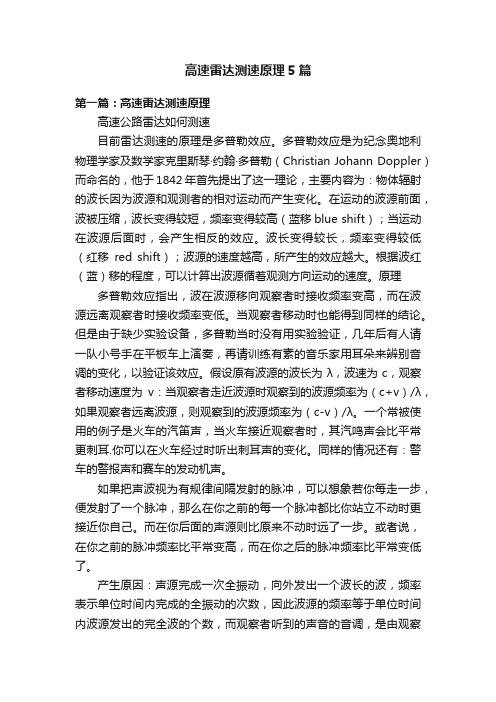
高速雷达测速原理5篇第一篇:高速雷达测速原理高速公路雷达如何测速目前雷达测速的原理是多普勒效应。
多普勒效应是为纪念奥地利物理学家及数学家克里斯琴·约翰·多普勒(Christian Johann Doppler)而命名的,他于1842年首先提出了这一理论,主要内容为:物体辐射的波长因为波源和观测者的相对运动而产生变化。
在运动的波源前面,波被压缩,波长变得较短,频率变得较高(蓝移blue shift);当运动在波源后面时,会产生相反的效应。
波长变得较长,频率变得较低(红移red shift);波源的速度越高,所产生的效应越大。
根据波红(蓝)移的程度,可以计算出波源循着观测方向运动的速度。
原理多普勒效应指出,波在波源移向观察者时接收频率变高,而在波源远离观察者时接收频率变低。
当观察者移动时也能得到同样的结论。
但是由于缺少实验设备,多普勒当时没有用实验验证,几年后有人请一队小号手在平板车上演奏,再请训练有素的音乐家用耳朵来辨别音调的变化,以验证该效应。
假设原有波源的波长为λ,波速为c,观察者移动速度为v:当观察者走近波源时观察到的波源频率为(c+v)/λ,如果观察者远离波源,则观察到的波源频率为(c-v)/λ。
一个常被使用的例子是火车的汽笛声,当火车接近观察者时,其汽鸣声会比平常更刺耳.你可以在火车经过时听出刺耳声的变化。
同样的情况还有:警车的警报声和赛车的发动机声。
如果把声波视为有规律间隔发射的脉冲,可以想象若你每走一步,便发射了一个脉冲,那么在你之前的每一个脉冲都比你站立不动时更接近你自己。
而在你后面的声源则比原来不动时远了一步。
或者说,在你之前的脉冲频率比平常变高,而在你之后的脉冲频率比平常变低了。
产生原因:声源完成一次全振动,向外发出一个波长的波,频率表示单位时间内完成的全振动的次数,因此波源的频率等于单位时间内波源发出的完全波的个数,而观察者听到的声音的音调,是由观察者接受到的频率,即单位时间接收到的完全波的个数决定的。
高速公路雷达探测资料分析共135页文档

11、获得的成功越大,就越令人高兴 。野心 是使人 勤奋的 原因, 节制使 人枯萎 。 12、不问收获,只问耕耘。如同种树 ,先有 根茎, 再有枝 叶,尔 后花实 ,好好 劳动, 不要想 太多, 那样只 会使人 胆孝懒 惰,因 为不实 践,甚 至不接 触社会 ,难道 你是野 人。(名 言网) 13、不怕,不悔(虽然只有四个字,但 常看常 新。 14、我在心里默默地为每一个人祝福 。我爱 自己, 我用清 洁与节 制来珍 惜我的 身体, 我用智 慧和知 识充实 我的头 脑。 15、这世上的一切都借希望而完成。 农夫不 会播下 一粒玉 米,如 果他不 曾希望 它长成 种籽; 单身汉 不会娶 妻,如 果他不 曾希望 有小孩 ;商人 或手艺 人不会 工作, 如果他 不曾希 望因此 而有收 益。-- 马钉路 德。
42、只有在人群中间,才能认识自 己。——德国
43、重复别人所说的话,只需要教育; 而要挑战别人所说的话,则需要头脑。—— 玛丽·佩蒂博恩·普尔
44、卓越的人一大优点是:在不利与艰 难的遭遇里百折不饶。——贝多芬
45、自己的饭量自己知道。——苏联
ቤተ መጻሕፍቲ ባይዱ
41、学问是异常珍贵的东西,从任何源泉吸 收都不可耻。——阿卜·日·法拉兹
- 1、下载文档前请自行甄别文档内容的完整性,平台不提供额外的编辑、内容补充、找答案等附加服务。
- 2、"仅部分预览"的文档,不可在线预览部分如存在完整性等问题,可反馈申请退款(可完整预览的文档不适用该条件!)。
- 3、如文档侵犯您的权益,请联系客服反馈,我们会尽快为您处理(人工客服工作时间:9:00-18:30)。
劳雷公司 2007年1月
测量
空气耦合天线安装工作照片
• • • • 天线安装在汽车之前 天线安装在汽车之后 天线安装支架组装方法 天线安装,技术参数
支架加固
DMI安装步骤和工作照片
空气耦合天线工作原理
地质雷达信号
地质模型 数学模型 脉冲 ricker子波
Simple point & click technique - Single click to undo layer picking
7米电缆固定
测点:Scans/m
10 Scans/m
5 Scans/m
2.5
1
测点:Scans/m – 管道
20 Scans/m
10 Scans/m
5
数据采集注意事项
Thickness = (2WTT x velocity)/2
Calibrate the Horn Antenna
• Place a 1.2x1.2 metal plate beneath the horn antenna. Make sure it is centered under the antenna and make sure there is 3 m (10 ft) of clear space around the antenna (except for the mounting vehicle)
position首波/信号位置ns range记录长度 gain增益 FIR filter滤波范围
• 天线参数
参数要求
• 信号位置--首波position(ns) • 记录长度--range(ns)
RoadScan GPR System How does it work?
VAIR(1 Ap ) Am VL (1 Ap ) Am
h:地层底界面深度(m) t:电磁波传播双程时间(ns) c:电磁波在空气中的传播速度(m/ns) v:电磁波在材料中的传播速度(m/ns) ε:材料的介电常数 εr:材料的相对介电常数
反射波极性:正波,负波
负波
正波
** A positive polarity reflection occurs when the layer beneath the interface possesses a propagation velocity less than the layer above the interface. The converse is true for a negative polarity reflection.
Pavement layer velocities are calculated based on the pavement reflection and the metal plate reflection. (Equation above assumes no separation distance between transmit and receive antennas. Actual equation used for antennas requires finding the roots of a 4th order polynomial equation.)
(b) Example of Correct Signal Position
Having saved projects on the SIR-20 will prevent positioning problems
首波错位
• 地面反射波 • 地面反射波同相轴错断 • 地面反射波校准(水平)
地层底界面深度计算
RoadScan GPR System How does it work?
An antenna calibration file is collected using a metal plate as a perfect reflector
Antenna Calibration file
Height variations are recorded along with corresponding metal plate amplitude
VL = velocity of layer (in/ns or m/ns) Ap= Amplitude of pavement reflection Am= Amplitude of metal plate reflection VAIR = propagation velocity in air 11.811 in/ns or 0.3 m/ns
Antenna Calibration file
Height variations are recorded along with corresponding metal plate amplitude
“Bumper Jump”
Bumper Jump file
斜坡文件
A-1
B-1
A-2
“Bumper Jump”
Bumper Jump file
Position Correction: -97 ns Range: 12 ns
Position Correction -96 nS
Position Correction -90 nS
Data Collection Concerns
(1)Make sure the correct portion of the direct-coupling is located within the time window.
公路雷达测试原理示意图
How does GPR work?
We record the two way travel time and the amplitude of the reflection
RoadScan GPR System How does it work?
Antenna
Direct Coupling
Thickness = (2WTT x velocity)/2
空气耦合天线标定
• • • • 选择 1.2x1.2 米 金属板 足够大 金属板位于天线正下方 金属板与天线中心重合 确保3米范围内没有电磁设备干扰,除了测量 车本身。
地质雷达工作原理--路面雷达理论依据
An antenna calibration file is collected using a metal plate as a perfect reflector
实际资料
软件方面
实际测量资料--首波不完整
软件方面
地质雷达工作原理--路面雷达理论依据
VAIR(1 Ap ) Am VL (1 Ap ) Am
VL = velocity of layer (in/ns or m/ns) Ap= Amplitude of pavement reflection Am= Amplitude of metal plate reflection VAIR = propagation velocity in air 11.811 in/ns or 0.3 m/ns
错刺现象原因:硬件方面
天线支架高度
硬件方面
硬件方面
错刺现象原因:硬件方面
错刺 问题
硬件方面
解决方案:天线支架安装建议
硬件方面
GSSI雷达的DMI测距系统
软件方面
为什么出现错刺现象?
• 首波问题 • 首波不完整,造成处理结果出现明显的 错刺现象。 • 铁板文件 • 实际测量文件 • 铁板文件和实际测量文件首波不一致, 造成比对错误 • 仪器加热时间不充足,导致首波不稳定
解释结果
EZ Tracker智能识别模式
现场打孔
硬件方面
为什么出现错刺现象?
• • • • • 仪器安装的关键 天线地面距离地面高度范围:45厘米 天线底面与地面平行 这个要求比较高, 常见问题表现如下:
• 天线支架非水平, • 天线4个角不在一个水平面上 • 测试前后天线支架的稳固性
硬件方面
Position -97.7 nS
软件方面
铁板文件首波错误
实际资料
软件方面
确保直达波记录在扫描窗口内
可接受的信号位置 (full positive lobe of wave in window) 不可接受的信号位置 (a portion of the positive lobe of wave not recorded)
Pavement layer velocities are calculated based on the pavement reflection and the metal plate reflection. (Equation above assumes no separation distance between transmit and receive antennas. Actual equation used for antennas requires finding the roots of a 4th order polynomial equation.)
检测结果
自动增益处理前
自动增益处理后
GPR and FWD Integration
Short run GPR file - raw data 10 scans/ft
Pavement surface
Bottom of asphalt
EZ Tracker
Automatic macro process applies calibration file and opens EZ Tracker
Should not be seen in time window
(a) Example of incorrect Signal Position
